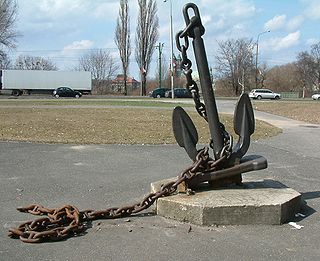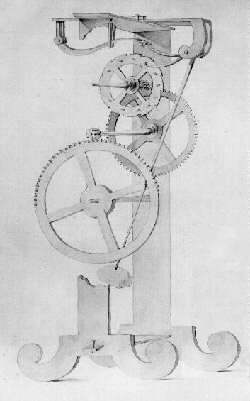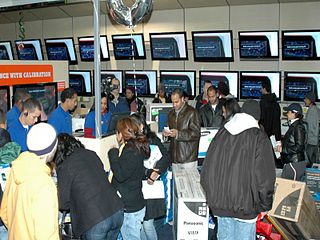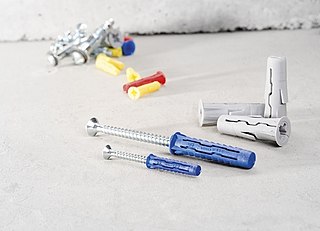
An anchor is a device, normally made of metal, used to secure a vessel to the bed of a body of water to prevent the craft from drifting due to wind or current. The word derives from Latin ancora, which itself comes from the Greek ἄγκυρα.

A pendulum clock is a clock that uses a pendulum, a swinging weight, as its timekeeping element. The advantage of a pendulum for timekeeping is that it is an approximate harmonic oscillator: It swings back and forth in a precise time interval dependent on its length, and resists swinging at other rates. From its invention in 1656 by Christiaan Huygens, inspired by Galileo Galilei, until the 1930s, the pendulum clock was the world's most precise timekeeper, accounting for its widespread use. Throughout the 18th and 19th centuries, pendulum clocks in homes, factories, offices, and railroad stations served as primary time standards for scheduling daily life, work shifts, and public transportation. Their greater accuracy allowed for the faster pace of life which was necessary for the Industrial Revolution. The home pendulum clock was replaced by less-expensive, synchronous, electric clocks in the 1930s and '40s. Pendulum clocks are now kept mostly for their decorative and antique value.

A watch is a portable timepiece intended to be carried or worn by a person. It is designed to keep a consistent movement despite the motions caused by the person's activities. A wristwatch is designed to be worn around the wrist, attached by a watch strap or other type of bracelet, including metal bands, leather straps, or any other kind of bracelet. A pocket watch is designed for a person to carry in a pocket, often attached to a chain.
Climbing protection are the mechanical devices and pieces of equipment used by climbers to reduce the risks, and the effects, of a fall to the climber while rock climbing or ice climbing. It includes such items as nylon webbing and metal nuts, cams, bolts, and pitons.

Components of an electrical circuit are electrically connected if an electric current can run between them through an electrical conductor. An electrical connector is an electromechanical device used to create an electrical connection between parts of an electrical circuit, or between different electrical circuits, thereby joining them into a larger circuit. Most electrical connectors have a gender – i.e. the male component, called a plug, connects to the female component, or socket. The connection may be removable, require a tool for assembly and removal, or serve as a permanent electrical joint between two points. An adapter can be used to join dissimilar connectors.

Consumer electronics or home electronics are electronic equipment intended for everyday use, typically in private homes. Consumer electronics include devices used for entertainment, communications and recreation. Usually referred to as black goods due to many products being housed in black or dark casings. This term is used to distinguish them from "white goods" which are meant for housekeeping tasks, such as washing machines and refrigerators, although nowadays, these would be considered black goods, some of these being connected to the Internet. In British English, they are often called brown goods by producers and sellers. In the 2010s, this distinction is absent in large big box consumer electronics stores, which sell entertainment, communication and home office devices, light fixtures and appliances, including the bathroom type.

A mooring is any permanent structure to which a seaborne vessel may be secured. Examples include quays, wharfs, jetties, piers, anchor buoys, and mooring buoys. A ship is secured to a mooring to forestall free movement of the ship on the water. An anchor mooring fixes a vessel's position relative to a point on the bottom of a waterway without connecting the vessel to shore. As a verb, mooring refers to the act of attaching a vessel to a mooring.

Glossary of climbing terms relates to rock climbing, mountaineering, and to ice climbing.

An escapement is a mechanical linkage in mechanical watches and clocks that gives impulses to the timekeeping element and periodically releases the gear train to move forward, advancing the clock's hands. The impulse action transfers energy to the clock's timekeeping element to replace the energy lost to friction during its cycle and keep the timekeeper oscillating. The escapement is driven by force from a coiled spring or a suspended weight, transmitted through the timepiece's gear train. Each swing of the pendulum or balance wheel releases a tooth of the escapement's escape wheel, allowing the clock's gear train to advance or "escape" by a fixed amount. This regular periodic advancement moves the clock's hands forward at a steady rate. At the same time, the tooth gives the timekeeping element a push, before another tooth catches on the escapement's pallet, returning the escapement to its "locked" state. The sudden stopping of the escapement's tooth is what generates the characteristic "ticking" sound heard in operating mechanical clocks and watches.
A grandfather clock is a tall, freestanding, weight-driven pendulum clock with the pendulum held inside the tower or waist of the case. Clocks of this style are commonly 1.8–2.4 metres (6–8 feet) tall with an enclosed pendulum and weights suspended by either cables or chains, which have to be occasionally calibrated to keep the proper time. The case often features elaborately carved ornamentation on the hood, which surrounds and frames the dial, or clock face. The English clockmaker William Clement is credited with developing this form in 1670. Until the early 20th century, pendulum clocks were the world's most accurate timekeeping technology, and longcase clocks, due to their superior accuracy, served as time standards for households and businesses. Today they are kept mainly for their decorative and antique value, which has been widely replaced by analog and digital timekeeping.

The Friden Flexowriter produced by the Friden Calculating Machine Company, was a teleprinter, a heavy-duty electric typewriter capable of being driven not only by a human typing, but also automatically by several methods, including direct attachment to a computer and by use of paper tape.

In horology, the anchor escapement is a type of escapement used in pendulum clocks. The escapement is a mechanism in a mechanical clock that maintains the swing of the pendulum by giving it a small push each swing, and allows the clock's wheels to advance a fixed amount with each swing, moving the clock's hands forward. The anchor escapement was so named because one of its principal parts is shaped vaguely like a ship's anchor.

A utility pole is a column or post typically made out of wood used to support overhead power lines and various other public utilities, such as electrical cable, fiber optic cable, and related equipment such as transformers and street lights. It can be referred to as a transmission pole, telephone pole, telecommunication pole, power pole, hydro pole, telegraph pole, or telegraph post, depending on its application. A Stobie pole is a multi-purpose pole made of two steel joists held apart by a slab of concrete in the middle, generally found in South Australia.

A drogue is a device trailed behind a boat on a long line attached to the stern. A drogue is used to slow the boat down in a storm and to prevent the hull from becoming side-on to the waves. A boat that has deployed a drogue should not overspeed down the slope of a wave and crash into the next one, nor will the vessel broach. By slowing the vessel, the drogue makes the vessel easier to control in heavy weather and will help to prevent pitchpoling.
A pattress or pattress box or fitting box is the container for the space behind electrical fittings such as power outlet sockets, light switches, or fixed light fixtures. Pattresses may be designed for either surface mounting or for embedding in the wall or skirting board. Some electricians use the term "pattress box" to describe a surface-mounted box, although simply the term "pattress" suffices. The term "flush box" is used for a mounting box that goes inside the wall, although some use the term "wall box". Boxes for installation within timber/plasterboard walls are usually called "cavity boxes" or "plasterboard boxes". A ceiling-mounted pattress is referred to as a "ceiling pattress" or "ceiling box". British English speakers also tend to say "pattress box" instead of just "pattress". Pattress is alternatively spelt "patress" and Wiktionary lists both spellings. The word "pattress", despite being attested from the late 19th century, is still rarely found in dictionaries. It is etymologically derived from pateras. The term is not used by electricians in the United States.

Fuji Electric Co., Ltd., operating under the brand name FE, is a Japanese electrical equipment company, manufacturing pressure transmitters, flowmeters, gas analyzers, controllers, inverters, pumps, generators, ICs, motors, and power equipment.

A wall plug, also known as an anchor (US) or "Rawlplug" (UK), is a fibre or plastic insert used to enable the attachment of a screw in material that is porous or brittle or that would otherwise not support the weight of the object attached with the screw. It is a type of anchor that, for example, allows screws to be fitted into masonry walls. In US English, mentions of drywall anchors are sometimes meant to refer specifically to the type of plastic wall plugs with expandable wings for hollow walls, in contradistinction with mollies and toggle bolts.

Caving equipment is equipment used by cavers and speleologists to aid and protect them while exploring caves. The term may also be used to refer to equipment used to document caves, such as photographic and surveying equipment. Originally, cave diving equipment was quite limited, but the increasing popularity of caving during the 20th century led to the creation of specialist caving equipment and companies.

Hubbell Incorporated is an American company that designs, manufactures, and sells electrical and electronic products for non-residential and residential construction, industrial, and utility applications. Hubbell was founded by Harvey Hubbell as a proprietorship in 1888, and was incorporated in Connecticut in 1905. It is ranked 602 by Fortune. The company’s reporting segments consist of the electrical segment and the Power segment. Hubbell’s manufacturing facilities are located in the United States, Canada, Switzerland, Puerto Rico, Mexico, China, Italy, the United Kingdom, Brazil and Australia and maintains sales offices in Singapore, China, India, Mexico, South Korea, and countries in the Middle East. Hubbell was previously headquartered in Orange, Connecticut, and has now moved its headquarters to Shelton, Connecticut. Hubbell Inc. assisted Allied efforts during World War II by manufacturing military vehicle electrical circuits, battery-charging systems for M4 Sherman tanks, power jacks for test meters, vacuum tube sockets for radio communications, and a line of electrical and electronic connectors for aircraft. Hubbell Inc. is in List of S&P 400 companies having stocks that are included in the S&P 400 stock market index, maintained by S&P Dow Jones Indices.














